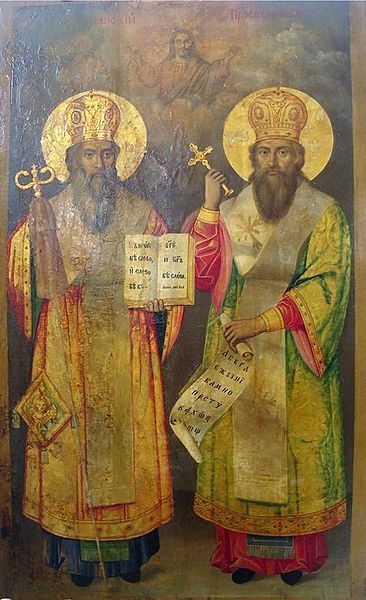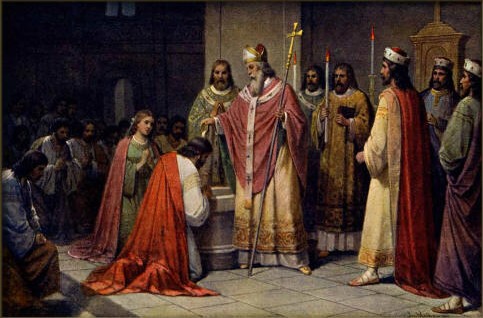Sts. Cyril and Methodius
 These brothers, the Apostles of the Slavs, were born in Thessalonica, in 827 and 826 respectively. Though belonging to a senatorial family they renounced secular honors and became priests. They were living in a monastery on the Bosphorus, when the Khazars sent to Constantinople for a Christian teacher. Cyril was selected and was accompanied by his brother. They learned the Khazar language and converted many of the people. Soon after the Khazar mission there was a request from the Moravians for a preacher of the Gospel. German missionaries had already labored among them, but without success. The Moravians wished a teacher who could instruct them and conduct Divine service in the Slavonic tongue. On account of their acquaintance with the language, Cyril and Methodius were chosen for their work. In preparation for it Cyril invented an alphabet and, with the help of Methodius, translated the Gospels and the necessary liturgical books into Slavonic. They went to Moravia in 863, and labored for four and a half years. Despite their success, they were regarded by the Germans with distrust, first because they had come from Constantinople where schism was rife, and again because they held the Church services in the Slavonic language. On this account the brothers were summoned to Rome by Nicholas I, who died, however, before their arrival. His successor, Adrian II, received them kindly. Convinced of their orthodoxy, he commended their missionary activity, sanctioned the Slavonic Liturgy, and ordained Cyril and Methodius bishops. Cyril, however, was not to return to Moravia. He died in Rome, 4 Feb., 869.
These brothers, the Apostles of the Slavs, were born in Thessalonica, in 827 and 826 respectively. Though belonging to a senatorial family they renounced secular honors and became priests. They were living in a monastery on the Bosphorus, when the Khazars sent to Constantinople for a Christian teacher. Cyril was selected and was accompanied by his brother. They learned the Khazar language and converted many of the people. Soon after the Khazar mission there was a request from the Moravians for a preacher of the Gospel. German missionaries had already labored among them, but without success. The Moravians wished a teacher who could instruct them and conduct Divine service in the Slavonic tongue. On account of their acquaintance with the language, Cyril and Methodius were chosen for their work. In preparation for it Cyril invented an alphabet and, with the help of Methodius, translated the Gospels and the necessary liturgical books into Slavonic. They went to Moravia in 863, and labored for four and a half years. Despite their success, they were regarded by the Germans with distrust, first because they had come from Constantinople where schism was rife, and again because they held the Church services in the Slavonic language. On this account the brothers were summoned to Rome by Nicholas I, who died, however, before their arrival. His successor, Adrian II, received them kindly. Convinced of their orthodoxy, he commended their missionary activity, sanctioned the Slavonic Liturgy, and ordained Cyril and Methodius bishops. Cyril, however, was not to return to Moravia. He died in Rome, 4 Feb., 869.
At the request of the Moravian princes, Rastislav and Svatopluk, and the Slav Prince Kocel of Pannonia, Adrian II formed an Archdiocese of Moravia and Pannonia, made it independent of the German Church, and appointed Methodius archbishop. In 870 King Louis and the German bishops summoned Methodius to a synod at Ratisbon. Here he was deposed and condemned to prison. After three years he was liberated at the command of Pope John VIII and reinstated as Archbishop of Moravia. He zealously endeavored to spread the Faith among the Bohemians, and also among the Poles in Northern Moravia. Soon, however, he was summoned to Rome again in consequence of the allegations of the German priest Wiching, who impugned his orthodoxy, and objected to the use of Slavonic in the liturgy. But John VIII, after an inquiry, sanctioned the Slavonic Liturgy, decreeing, however, that in the Mass the Gospel should be read first in Latin and then in Slavonic.
 Wiching, in the meantime, had been nominated one of the suffragan bishops of Methodius. He continued to oppose his metropolitan, going so far as to produce spurious papal letters. The pope, however, assured Methodius that they were false. Methodius went to Constantinople about this time, and with the assistance of several priests, he completed the translation of the Holy Scriptures, with the exception of the Books of Machabees. He translated also the “Nomocanon”, i.e. the Greek ecclesiastic-civil law. The enemies of Methodius did not cease to antagonize him. His health was worn out from the long struggle, and he died 6 April, 885, recommending as his successor Gorazd, a Moravian Slav who had been his disciple.
Wiching, in the meantime, had been nominated one of the suffragan bishops of Methodius. He continued to oppose his metropolitan, going so far as to produce spurious papal letters. The pope, however, assured Methodius that they were false. Methodius went to Constantinople about this time, and with the assistance of several priests, he completed the translation of the Holy Scriptures, with the exception of the Books of Machabees. He translated also the “Nomocanon”, i.e. the Greek ecclesiastic-civil law. The enemies of Methodius did not cease to antagonize him. His health was worn out from the long struggle, and he died 6 April, 885, recommending as his successor Gorazd, a Moravian Slav who had been his disciple.
cfr. L. ABRAHAM (Catholic Encyclopedia)
_________________________









